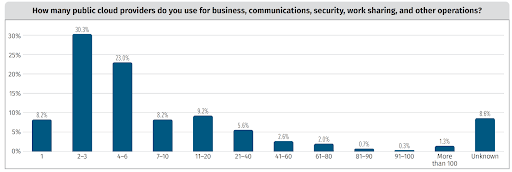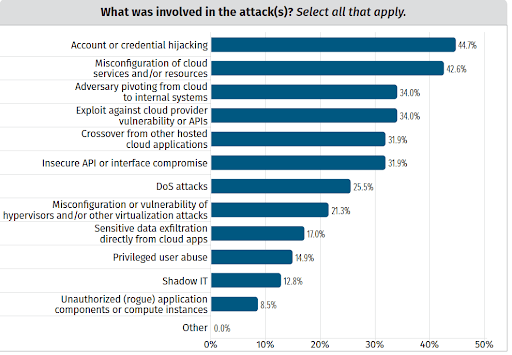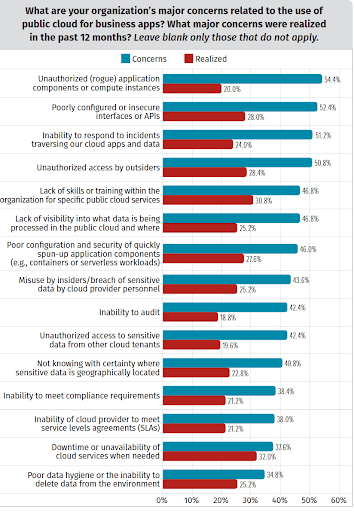SANS Cloud Security Survey 2022 – Highlights
Published 04/14/2022
 This blog was originally published by Vulcan Cyber here.
This blog was originally published by Vulcan Cyber here.
Written by Orani Amroussi, Vulcan Cyber.
In 2022, security issues have increased in cloud assets, leading to more data breaches involving cloud environments. But, despite the growing threats and attached cyber risk, organizations are undeterred in migrating to the cloud with greater acceleration than ever before.
But is the greater exposure to cyber risk matched by organizations taking the steps to improve the security around and within their cloud environments? In the latest report by SANS, produced in partnership with Vulcan Cyber, we see organizations placing greater emphasis on their cloud security efforts.
Meanwhile, the concerns themselves have shifted to focus more on the areas that in the past have received less attention.
Here are just some of the highlights of the report, available here as Cloud security risks in 2022 – where we stand.
Multi-Cloud Environments Are Becoming More Commonplace
2022 again saw a steady increase in organizations taking advantage of multi-cloud environments:

The number of organizations using 11-20 cloud providers, for example, increased from 3% in 2021 to 9% in 2022.
But as teams grow bolder in their harnessing of cloud technologies, they must scale up and optimize their security efforts to counter the attached cyber risk. Multi-cloud environments mean a wider attack surface. Threats inevitably rise and mitigating that risk requires robust security controls tailored to this unique new threatscape.
Teams Are Taking Care of Cloud Security Basics – But It's Not Enoug
As cloud grows, teams are growing more confident in the basics of locking down their cloud environments against the types of threats that were big areas of concern in the past. The number of DDoS attacks, for example, has continued its downward trend from 2021, involved in just 25% of the attacks covered in this survey.

But there remain big security concerns that have increased in risk in 2022. Misconfigurations and operational and workflow failings are big contributors to the major breaches of the past year:

The biggest issues stem from the wrong configurations, personnel inefficiencies and a lack of resources, rather than outright unauthorized access. In contrast, in the years before 2022 unauthorized access was the biggest concern for organizations.
This shift is important. Protecting against obvious threats is just a part of maintaining good security posture. Inefficient processes, flawed workflows, and untrained personnel all contribute to and have significant effects on cyber hygiene. For a threat actor, every minor configuration is an opportunity to cause chaos.
The Brave New World o Remote Work…And Increased Cyber Risk
The unprecedented increase in remote work over the last 12 months has left most respondents (62%) in agreement over the amplified cyber risk attached. Those concerned cited the lack of oversight and monitoring capability, and remote user compromise, as the main drivers of this risk.
The era of remote work seems to be here to stay, at least to an extent. It’s now more integral than ever to ensure robust security controls are in place within organizations, and that employees are properly trained and equipped to support these security efforts.
As teams adjust to a new working model, individuals carry significant responsibility for the security of their devices and environments – and they must be proactive about ensuring this. But organizations need to recognize that this effort should be implemented and encouraged from the top down, with all teams pulling together to put cyber risk front and center of employees’ workflows.
The Potential and Pitfalls of the Cloud
The benefits of migrating to a cloud environment are clear to see. The speed, ease of use, and convenience of cloud computing make it a tempting proposition – and organizations are lining up to take advantage. This trend will only continue as teams adjust to hybrid working models. But as cloud migration increases, so does the level of cyber risk. It’s important for organizations to acknowledge and address proactively the cyber security ramifications of a new environment that has emerged as a major attack surface in recent years.
Cloud security requires customized tools and processes. Teams must be trained and given the resources and instruction to become active parts of the cyber risk management lifecycle. This is true of all cyber security efforts, but with every connected device having potentially easy access to sensitive data stored on the cloud, the need for a shared responsibility approach to security has never been more pronounced.
Cyber risk is always evolving. Organizations need to recognize it, understand what it means to them specifically, and take the necessary steps to address it. This is a process of processes – the responsibilities split across different teams with different workflows and levels of understanding when it comes to security. Meanwhile, the risk isn’t waiting for you to figure it out.
This blog is based on the latest cloud security by SANS – available here as Cloud security risks in 2022 – where we stand.
About the Author

Unlock Cloud Security Insights
Subscribe to our newsletter for the latest expert trends and updates
Related Articles:
The Internet is a Single Point of Failure
Published: 11/21/2025
Implementing CCM: Threat & Vulnerability Management Controls
Published: 11/21/2025
Red Teaming Voice AI: Securing the Next Generation of Conversational Systems
Published: 11/20/2025
It’s Time to Make Cloud Threat Modeling Continuous
Published: 11/20/2025



.jpeg)

.jpeg)
.jpeg)